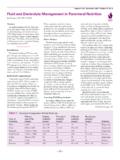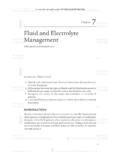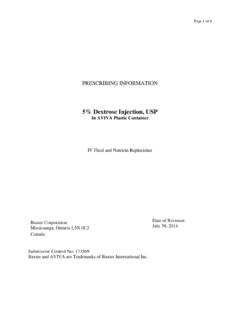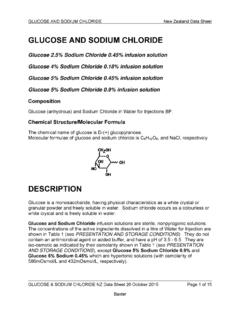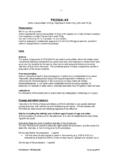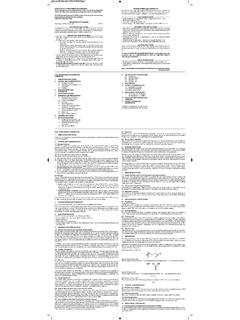Transcription of Fluid and Electrolyte Disturbances Associated with …
1 Chapter 12 Fluid and Electrolyte Disturbances Associated with Tube FeedingsClinicians generally agree with the philosophy that Whenthe gut works, use it. That is, if gastrointestinal function ispresent, enteral feedings should be favored over parenteralnutrition. Aside from being less expensive, enteral feedingsare Associated with better preservation of both immunefunction and intestinal function. Nevertheless, tube feed-ings are not without problems. Primarily, these problemsarise because many tube-fed patients have preexisting fluidand Electrolyte imbalances Associated with their underlyingillnesses.
2 A multitude of enteral products are available;some are disease specific and others are standard (suit-able for most patients). It is important to review some ofthe characteristics of enteral formulas to understand theirpotential impact on Fluid and Electrolyte OSMOLALITYO smolality is an important characteristic of an enteral for-mula; it is primarily a function of the number and size ofmolecular and ionic particles in a given volume. Table 12-1shows the wide variance in osmolalities of some com-mercially available tube feeding formulas.
3 Whereas someformulas approximate the osmolality of plasma (300mOsm/kg) and, therefore, are deemed isotonic, othershave considerably higher osmolalities and are referred to as hypertonic. Isotonic formulas are generally well toler-ated; in contrast, hypertonic formulas can slow gastric em-ptying and cause nausea, vomiting, and distention. Whenhypertonic formulas are administered in the small bowel,179 Table 12-1 Characteristics of Selected Enteral FormulasContent (mg) per 8 Ounces of FormulaFormulaCal/mLOsmolalityNaKCaPMgGl ucerna 35522037017017067 Glucerna : All of the formulas are made by Abbott Laboratories, Abbott Park, Illinois.
4 Formulations may have changed since this table was prepared; refer to themanufacturer s 9/14/10 11:42 AM Page 179 Jones & Bartlett Learning, LLC. NOT FOR SALE OR DISTRIBUTION. Jones & Bartlett Learning, LLCNOT FOR SALE OR DISTRIBUTION Jones & Bartlett Learning, LLCNOT FOR SALE OR DISTRIBUTION Jones & Bartlett Learning, LLCNOT FOR SALE OR DISTRIBUTION Jones & Bartlett Learning, LLCNOT FOR SALE OR DISTRIBUTION Jones & Bartlett Learning, LLCNOT FOR SALE OR DISTRIBUTION Jones & Bartlett Learning, LLCNOT FOR SALE OR DISTRIBUTION Jones & Bartlett Learning, LLCNOT FOR SALE OR DISTRIBUTION Jones & Bartlett Learning, LLCNOT FOR SALE OR DISTRIBUTION Jones & Bartlett Learning, LLCNOT FOR SALE OR DISTRIBUTION Jones & Bartlett Learning.
5 LLCNOT FOR SALE OR DISTRIBUTION Jones & Bartlett Learning, LLCNOT FOR SALE OR DISTRIBUTION Jones & Bartlett Learning, LLCNOT FOR SALE OR DISTRIBUTION Jones & Bartlett Learning, LLCNOT FOR SALE OR DISTRIBUTION Jones & Bartlett Learning, LLCNOT FOR SALE OR DISTRIBUTION Jones & Bartlett Learning, LLCNOT FOR SALE OR DISTRIBUTION Jones & Bartlett Learning, LLCNOT FOR SALE OR DISTRIBUTION Jones & Bartlett Learning, LLCNOT FOR SALE OR DISTRIBUTION Jones & Bartlett Learning, LLCNOT FOR SALE OR DISTRIBUTION Jones & Bartlett Learning, LLCNOT FOR SALE OR DISTRIBUTION Jones & Bartlett Learning, LLCNOT FOR SALE OR DISTRIBUTION they create an osmotic gradient that pulls water into theintestine.
6 If the Fluid is not adequately absorbed, crampingand diarrhea may result. For this reason, hypertonic for-mulas are introduced slowly until the body has time toadapt to formula s osmolality affects the renal solute load andthus the water requirements. Renal solute load can bedefined as the sum of substances that must be excreted bythe kidneys (such as urea, potassium, sodium, and chlo-ride). A high renal solute load (created by nutrient use)requires a large water volume for excretion. If enough wateris not provided, the patient will become dehydrated.
7 There-fore, the renal solute load imposed by a formula should beconsidered in patients with impaired renal function and inthose with increased losses of body fluids (such as fromfever or diarrhea).A number of liquid medications administered via feedingtubes are hyperosmolar and can cause osmotic diarrhea ifgiven undiluted, especially into the small intestine. Amongthese products are acetaminophen, potassium chloride, andphosphosoda. For example, the osmolality of an acetamino-phen solution can range between 3000 and 6000 delivery of hyperosmolar preparations should be lim-ited to the stomach; even then, the medications should bediluted before administration and water flushes giventhrough the tube before and after delivery.
8 This action notonly dilutes the medication, but also enhances its absorp-tion. Of course, it is important to keep any Fluid restrictionsin mind. At times, the parenteral route may be necessary forelectrolyte supplements when they are not tolerated by theGI OF FORMULASC ommercial sources supply standardized as well as special-ized products targeted to patients with specific problems,such as renal, hepatic, and respiratory failure. Becausenumerous enteral formula products are available, it isimportant to read the literature supplied by formulas are classified as standard, elemental, or spe-cialized, with multiple formulas available in each FormulasA standard formula contains intact protein and is similar toan average diet for healthy individuals; it can be adminis-tered to patients with normal digestion.
9 These formulas areavailable with and without added fiber. Unless there is evi-dence to the contrary, a standard formula is the product ofchoice for the majority of tube-fed FormulasA calorie-dense formula usually contains kilocaloriesper milliliter of Fluid and is used in patients who requirefluid restriction for example, patients with congestiveheart failure, syndrome of inappropriate antidiuretic hor-mone (SIADH), or renal failure. For instance, for a patientrequiring 1800 kcal/day, the amount of water delivered inthe formula could be reduced by 900 mL merely by convert-ing from a calorie per milliliter formula to a caloriesper milliliter FormulasFiber-containing formulas may be helpful in patients withdiarrhea or constipation.
10 The fiber added to the formulaincreases stool bulk and helps to regulate bowel that the colon is the final site of water and elec-trolyte absorption and ultimately determines fecal composi-tion. In patients who can tolerate high-residue formulas,use of a high-fiber formula is thought to increase thesodium and water absorptive ability of the colon, therebyminimizing fecal Fluid loss. For example, in a study of agroup of 20 critically ill patients randomized to either a sol-uble fiber formula or a fiber-free formula, the number ofliquid stools was significantly lower in the fiber been recommended that this type of formula be consid-ered in patients for whom tube feedings will be the solesource of nutrition for a long period of time, especially ifintestinal disease is FormulasAn elemental formula contains hydrolyzed protein and sim-ple sugars.










